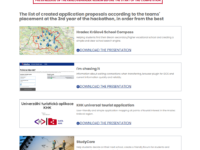The project proposes a system for extracting and analysing information from the medical records of breast cancer patients, using artificial intelligence. This would support research, personalised medicine and health decision-making, benefiting clinicians and regional authorities. This provides an automated alternative to accelerate translational research, promote personalised medicine and improve the efficiency of health services.
Innovation Tag: Data
vCity is a human-centric platform for urban digital twins, with the goal of improving life quality within the city by assisting urban planners make evidence-driven urban decisions. vCity's innovative approach combines 1) simulation by designing virtual replicas of the cities, 2) what-if scenario tools in urban planning and 3) getting the "pulse" of the city from digital platforms for citizen participation.
Bağcılar Municipality has implemented an Algorithmic Decision Systems model with the aim of maximizing the value proposition and satisfaction level offered to stakeholders at the minimum cost. This model enables the municipality to make decisions regarding the investment worthiness of its current and planned services and activities, as well as the direction of improvements needed in existing products and services, both in the eyes of stakeholders and the organization.
The data portal is a central data point for the public. It provides citizens with high-quality open data of the region, bringing it closer to the general public in user-friendly formats, in the form of map outputs. It is an innovative solution of the Hradec Králové Region for sharing and visualizing data from publicly available sources and data of the region. It ensures transparency, openness and accountability of public administration.
Case Study
High Impact Service Provider Case Study: Innovating the Individual Assistance Program For Survivors…
The Federal Emergency Management Agency (FEMA), a component of the United States’ Federal Government, has fully reimagined its DisasterAssistance.gov website to make applying for disaster assistance faster than ever. This change will reduce time burdens for survivors post-disaster, when they are in greatest need and the most overwhelmed. This effort has been built on decades of feedback from disaster survivors and is expected to reduce the registration time by more than 15%.
The Government of Canada is experimenting writing existing laws and proposed regulations into code. Encoding rules allows us to run legal simulations in the regulatory drafting room, which helps us detect ambiguities, loopholes, and gaps in the rules that often go unnoticed. However, existing tools designed by and for programmers are not intuitive for rule-makers. In response, we set out to develop one – an open-source Rules as Code tool called Blawx.
Case Study
Development and Operation of the 「Korea Voice Analysis Model (K-VoM) for Voice Phishing」,…
Monetary damage from voice phishing crime in Korea stands at 3 trillion won(US$2.24 billion) over the last five years, causing massive pain to citizens. The Ministry of the Interior and Safety (MOIS) developed the first ever voice analysis model that could precisely filter out criminal voices, track down individuals involved in voice phishing crime, and form criminal clusters. This technology sped up voice phishing crime investigations and is in turn leading to reduced damage for citizens.
The Information Portal improves the process of obtaining current information on court proceedings by participants in cases conducted in courts.Through this system, trial attorneys, lawyers, citizens participating in proceedings can find out about the current status of their cases without having to contact the court directly.The latest functionality has changed the purpose of the system, which now serves as the official channel of communication in civil proceedings between the court and the party
Case Study
Machine Learning Model for Type 2 Diabetes Mellitus Incidence Prediction for the People Medically…
The innovation was developed because the Costa Rican Social Security Fund seeks to work with strategies that allow the social security system to be sustainable given the limitations of public health and the increase in health spending.
This is the development of a machine learning predictive model to determine the propensity to develop Type II Diabetes Mellitus in patients with EDUS.
It is innovative as it is the first predictive model based on clinical data records stored in EDUS.
Case Study
Linkage to care – Removing communication barriers between Health care Facilities and Community…
Community Health Workers are a essential component of the health workforce who provide personalised directed health care in the comfort and safety of a patients home.
This innovation addressed the administrative injustice and barriers experienced y health care workers which result in gross under utilization of the resource.
The innovation automates arduous paper referral to a instant digital referral using Quick Response codes and existing tools in Office 365, all without leaving the bedside


